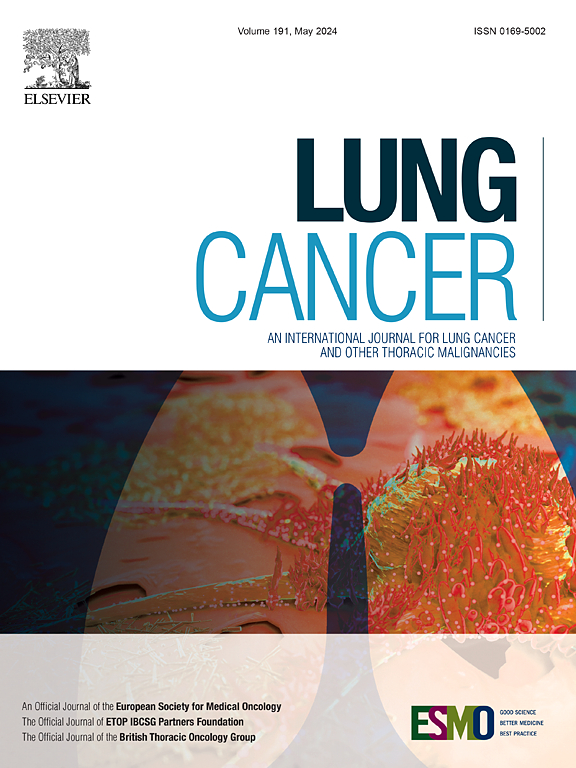高级别侵袭前支气管病变的治疗:治疗还是不治疗?
IF 4.4
2区 医学
Q1 ONCOLOGY
引用次数: 0
摘要
背景:高级别侵袭前支气管病变有可能发展为鳞状细胞癌(SCC),但其自然历史各不相同。这些病变的最佳管理是有争议的,不同机构的治疗策略不同。本研究旨在比较接受初级治疗的高级别侵袭性支气管内病变患者与接受进展治疗的患者的无进展生存期和总生存期。方法:我们在两个肿瘤中心进行了回顾性队列研究:伦敦大学学院医院(UCLH,英国)和阿姆斯特丹大学医学中心(AUMC,荷兰)。高度侵袭前病变患者接受重复支气管镜检查和CT扫描监测。在AUMC,患者常规接受支气管内初级治疗,而在UCLH,治疗保留给进展为SCC的病例。主要终点是无进展生存期(PFS),次要终点是总生存期(OS)。结果:在1998年至2017年期间,85例患者纳入研究:34例(40%)接受了初级治疗,51例(60%)接受了进展治疗。与原治疗组相比,后一组原位癌(CIS)的比例更高(78.4%比38.2%,p = 0.001),且明显更年轻(中位年龄:67.0比77.0岁,p = 0.001)。中位总随访时间为46.2个月。初级治疗与疾病进展风险显著降低相关(HR = 0.39, 95% CI: 0.21-0.73, p = 0.002)。初始治疗组的中位PFS为71.0个月,而进展治疗组为38.0个月(p = 0.002)。多因素Cox回归分析发现,初始治疗(HR = 0.47, 95% CI: 0.26-0.87, p = 0.015)和年龄(HR = 1.04, 95% CI: 1.01-1.07, p = 0.013)是OS的独立预测因素。结论:我们的研究表明,接受初级治疗的高级侵袭前病变患者的PFS和OS明显改善。本文章由计算机程序翻译,如有差异,请以英文原文为准。
Management of high-grade pre-invasive endobronchial lesions: To treat or not to treat?
Background
High-grade pre-invasive endobronchial lesions have the potential to progress to squamous cell carcinoma (SCC), but their natural history varies. The optimal management of these lesions is controversial, with treatment strategies varying across institutions. This study aims to compare the progression free and overall survival outcomes between patients with high-grade pre-invasive endobronchial lesions who received primary treatment versus patients who were treated on progression.
Methods
We conducted a retrospective cohort study across two oncology centers: University College London Hospitals (UCLH, United Kingdom) and Amsterdam University Medical Center (AUMC, The Netherlands). Patients with high-grade pre-invasive lesions underwent surveillance with repeat bronchoscopy and CT scans. At AUMC, patients routinely received endobronchial primary treatment, whereas at UCLH, treatment was reserved for cases that progressed to SCC. Primary outcome was progression-free survival (PFS), and the secondary outcome was overall survival (OS).
Results
Between 1998 and 2017, 85 patients were included in the study: 34 (40 %) received primary treatment, while 51 (60 %) received treatment on progression. The latter group had a higher proportion of carcinoma in situ (CIS) compared to the primary treatment group (78.4 % vs. 38.2 %, p = 0.001) and was significantly younger (median age: 67.0 vs. 77.0 years, p = 0.001). Median overall follow-up time was 46.2 months. Primary treatment was associated with a significantly reduced risk of disease progression (HR = 0.39, 95 % CI: 0.21–0.73, p = 0.002). Median PFS was 71.0 months in the primary treatment group versus 38.0 months in the treatment on progression group (p = 0.002). Multivariate Cox regression analysis identified both primary treatment (HR = 0.47, 95 % CI: 0.26–0.87, p = 0.015) and age (HR = 1.04, 95 % CI: 1.01–1.07, p = 0.013) as independent predictors of OS.
Conclusion
Our study showed that high-grade pre-invasive lesion patients who underwent primary treatment had a significantly improved PFS and OS.
求助全文
通过发布文献求助,成功后即可免费获取论文全文。
去求助
来源期刊

Lung Cancer
医学-呼吸系统
CiteScore
9.40
自引率
3.80%
发文量
407
审稿时长
25 days
期刊介绍:
Lung Cancer is an international publication covering the clinical, translational and basic science of malignancies of the lung and chest region.Original research articles, early reports, review articles, editorials and correspondence covering the prevention, epidemiology and etiology, basic biology, pathology, clinical assessment, surgery, chemotherapy, radiotherapy, combined treatment modalities, other treatment modalities and outcomes of lung cancer are welcome.
 求助内容:
求助内容: 应助结果提醒方式:
应助结果提醒方式:


